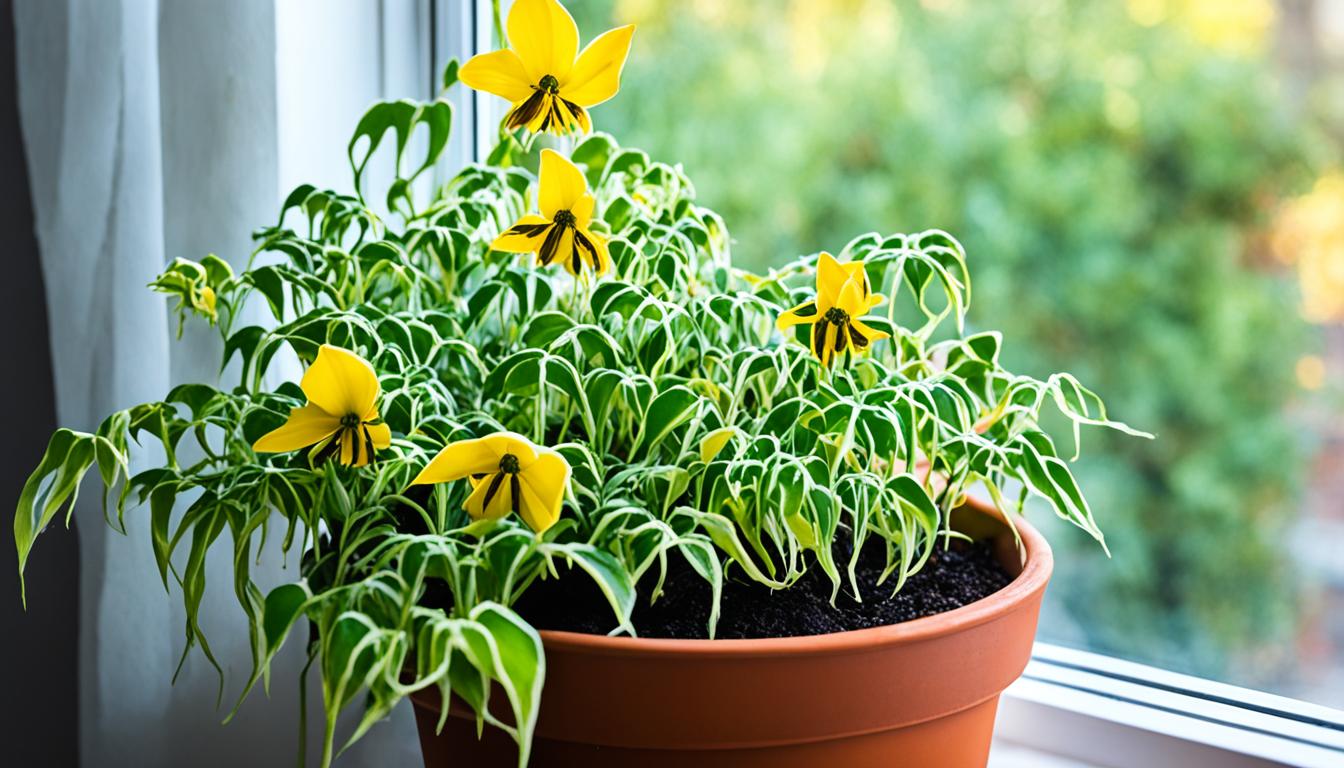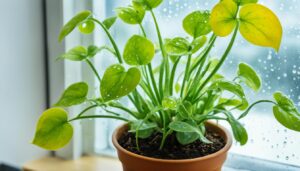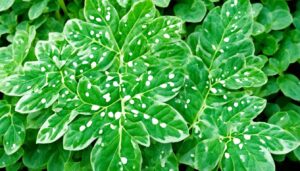Do you feel like your indoor plants are stuck in a perpetual state of stunted growth, no matter how much effort you put into their care? If so, you’re not alone. Many plant enthusiasts struggle to keep their houseplants thriving, especially with indoor challenges. But what if the solution was simpler than you thought?
Identifying and fixing the underlying issues could be the key to a lush, vibrant indoor garden. Get ready to discover the secrets to making your indoor plants flourish and transform your living space.
Identifying the Reasons Behind Stunted Plant Growth Indoors
If your indoor plants have stopped growing, it’s important to find out why. Improper lighting and watering are often the main causes. Fixing these issues can help your houseplants grow again.
Light Requirements
Good lighting is key for healthy indoor plants. Some plants love bright sunlight, while others do better in softer light. If your plant isn’t getting enough light, it won’t grow well. Move them away from bright windows or use grow lights if it’s too dim. Also, keep leaves clean to let them get enough sunlight.
Watering Issues
Not watering enough or too much can stunt plant growth. Don’t water on a set schedule. Instead, water when the soil feels dry. Make sure pots drain well to prevent waterlogged soil. Empty any extra water from the pot after a few minutes to keep plants dry.
By looking at your plants’ light and water needs, you can fix their stunted growth. Keep an eye on them and adjust as needed for better growth.
| Light Requirement | Plant Examples |
|---|---|
| Bright, Direct Sunlight | Succulents, cacti, geraniums |
| Moderate, Indirect Light | Philodendrons, pothos, ZZ plants |
| Low Light | Snake plants, Chinese evergreens, peace lilies |
Proper lighting is the foundation for healthy, thriving indoor plants.”
Nutrient Deficiencies and Proper Fertilization
For indoor gardens to flourish, it’s not just about sunlight and water. Proper fertilization is key to giving plants the nutrients they need. If you don’t fertilize correctly, your plants may suffer from nutrient shortages and slow growth.
Many indoor plant owners struggle with nutrient deficiencies in houseplants. These can show up as leaves turning color, growth slowing, and poor health. To fix these issues, use a balanced plant fertilizer and stick to a regular feeding plan.
| Nutrient | Deficiency Symptoms | Recommended Fertilizer |
|---|---|---|
| Nitrogen (N) | Older leaves turning yellow, stunted growth | Balanced, water-soluble fertilizer |
| Phosphorus (P) | Dull, purple-tinged leaves, poor root development | Balanced, water-soluble fertilizer |
| Potassium (K) | Leaf edges turning brown, slow growth | Balanced, water-soluble fertilizer |
When fertilizing indoor plants, choose a balanced, water-soluble fertilizer and follow the directions. Don’t overdo it, as too much fertilizer can harm your plants. Instead, feed them lightly and regularly when they’re growing. Cut back or stop fertilizing in the winter when plants sleep.
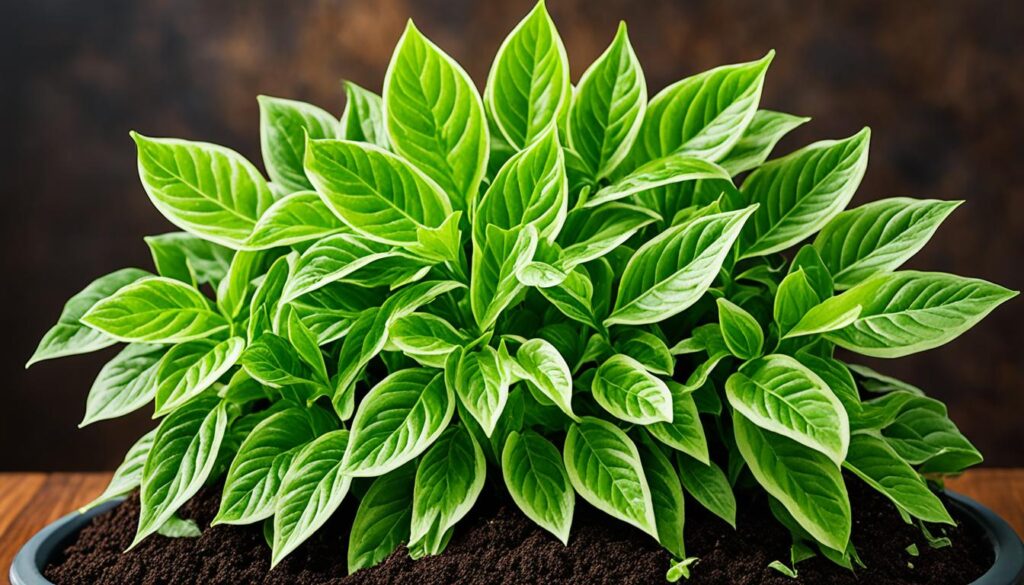
Knowing how to spot nutrient shortages and fertilizing indoor plants right can make a big difference. This way, your indoor plants will grow strong and beautiful.
Repotting and Rootbound Plants
If your indoor plants aren’t doing well, they might be rootbound. Rootbound houseplants show signs like roots on the soil surface or through the drainage hole. These plants have outgrown their pots, making it hard for them to get water and nutrients.
Signs of Rootbound Plants
- Roots visible on the soil surface or growing through the drainage hole
- Tightly packed, dense root system that’s difficult to remove from the pot
- Stunted growth, yellowing leaves, and wilting despite proper watering
- Roots circling the inside of the pot instead of growing outward
Repotting Techniques
To fix rootbound issues, it’s time to repot your plant. Pick a pot just a bit bigger than the old one to prevent overwatering. Carefully loosen the roots and put the plant in the new pot. Use fresh, quality potting mix and water well after.
Also, keep the plant out of direct sunlight until it settles in its new spot.
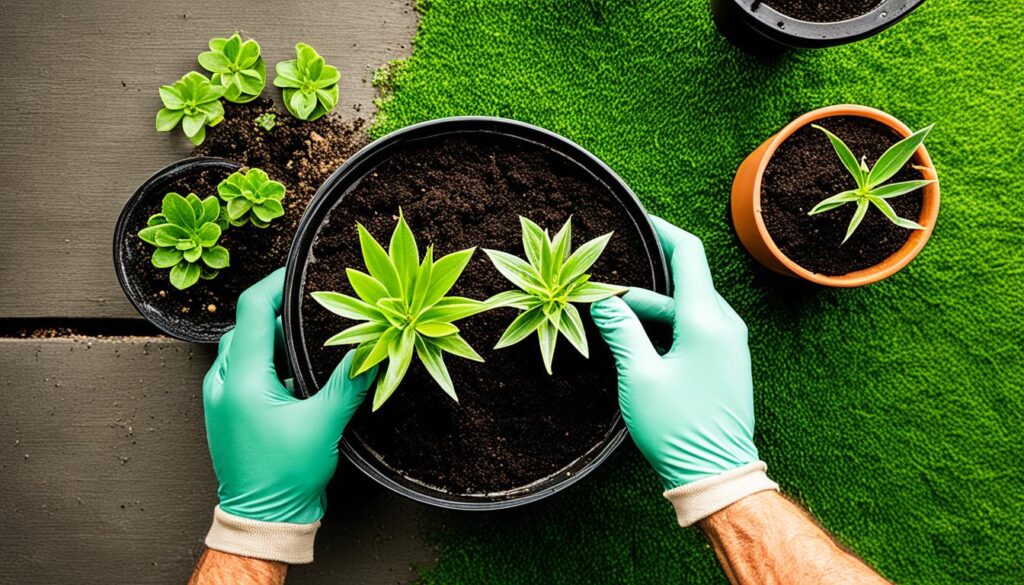
“Repotting is a crucial step in keeping your indoor plants thriving. It provides them with the space and nutrients they need to continue growing strong.”
Timing is everything for repotting. Spring or early summer is best when plants are growing fast. With the right care, your rootbound houseplants can bounce back and flourish.
Pests and Diseases Affecting Indoor Plants Not Growing
Many indoor plants don’t grow well because of pests and diseases. Tiny spider mites and aphids can harm your houseplants. They stop the plants from getting the nutrients they need.
Fungal problems like powdery mildew or somatic mold also hurt plant health. These diseases spread fast, making it hard for plants to grow well indoors.
Look out for these signs of pests and diseases:
- Visible insects or webbing on the leaves and stems
- Discoloration, yellowing, or wilting of the foliage
- Distorted or stunted growth
- Powdery or fuzzy white growth on the leaves
- Unusual spots, lesions, or other abnormal growths
If you think pests or diseases are harming your plants, act fast. Use the right insecticidal or fungicidal solutions to help them get better.
Maintaining the health and vitality of your indoor plants is essential for their continued growth and success.”
By being careful and acting quickly, you can help your indoor plants grow well. They can thrive even in tough conditions.
Troubleshooting Indoor Plants Not Growing
If your indoor plants aren’t doing well, check the environment and soil quality. This will help you find out why they’re struggling. By fixing these issues, you can make a better place for your plants to grow.
Assessing Environmental Conditions
Most indoor plants like temperatures between 65-75°F (18-24°C). They also prefer humidity levels of 40-60%. Good air circulation is key to keep them healthy and prevent diseases like powdery mildew.
To meet your plants’ needs, you might use a humidifier or adjust the thermostat. Placing fans can also help move air around your plants.
Checking Soil Quality
The type of potting soil you use is very important for your plants. Watch for signs of bad soil, like compaction or waterlogging. Use a well-draining potting mix that’s full of organic stuff to give your plants the right nutrients for houseplants.
If the soil is too dense, add compost, perlite, or sand to it. This will help with drainage and air flow. Making these changes can really help your plants grow better.
“The quality of the soil is just as important as the amount of sunlight and water your indoor plants receive. Don’t neglect this crucial component of healthy plant growth.”
Low Light Plant Care Tips
If your home doesn’t get a lot of sunlight, don’t worry. There are many low-light houseplants that can do well in these conditions. By learning about their needs, you can create a beautiful indoor garden, even in dim spaces.
The Chinese Evergreen is a great choice for low light. These plants are colorful and can handle a variety of light levels. Dracaenas also do well in low light, with their beautiful, long leaves.
Philodendrons are perfect for homes with little sunlight. They can grow up walls or hang in baskets, adding a tropical feel. The ZZ plant is easy to care for and can survive in very low light.
If your plants are struggling with light, think about using artificial grow lights. These lights can give your plants the extra light they need to stay healthy and grow.
When taking care of low-light plants, pay attention to how often you water and feed them. They usually need less water and a special kind of fertilizer to avoid problems.
With the right low-light plants and some care, you can have a beautiful indoor garden, even in dark spots. Take on the challenge and enjoy the rewards of having a thriving indoor garden, no matter the light.
| Low Light Houseplant | Light Requirement | Watering Needs |
|---|---|---|
| Chinese Evergreen | Moderate to low light | Water when the top inch of soil is dry |
| Dracaena | Moderate to low light | Water when the soil is partially dry |
| Philodendron | Low to medium light | Water when the top inch of soil is dry |
| ZZ Plant | Low to medium light | Water every 2-3 weeks |
Conclusion
Understanding why your indoor plants aren’t growing well can help you fix the problem. This guide gives you the key info to make your houseplants thrive. It covers lighting, watering, nutrients, pests, and diseases.
If your plants are struggling with low light, not getting enough nutrients, or are rootbound, this article has solutions. The tips and techniques here can help you fix these issues. By focusing on what your plants need and adjusting their care, you’ll soon have healthy, vibrant houseplants.
With the right knowledge and effort, you can turn your indoor plants from dull to dynamic. This will make your home look beautiful and peaceful. Follow these tips for healthy houseplants and enjoy a thriving indoor garden for many years.
FAQ
What are the common reasons behind stunted indoor plant growth?
Stunted indoor plants often face issues like bad lighting, watering problems, and not getting enough nutrients. Pests, diseases, and poor living conditions also play a part.
How do I know if my indoor plant is not getting enough light?
Look for signs like slow growth, long stems, and leaves that are too small or off-color. Move them away from bright windows or add grow lights if it’s too dim.
How can I tell if I’m overwatering or underwatering my indoor plants?
Overwatering can cause yellow leaves, wilting, and root rot. Underwatering makes leaves wilt and turn brown. Check the soil before watering to avoid these problems.
How do I know if my indoor plant needs fertilizer?
If your plant looks stunted, has yellow leaves, or looks unhealthy, it might need nutrients. Most houseplants do well with regular feeding when they’re growing. But, they don’t need much in the winter when they sleep.
How do I know if my indoor plant is rootbound?
Rootbound plants have roots on the soil surface or through the drainage hole. Their roots are packed tightly in the pot. Move them to a bigger pot with fresh soil to help them grow.
How can I identify and treat pests and diseases on my indoor plants?
Watch for pests like spider mites, aphids, or scale, and diseases like powdery mildew or mold. Use the right solutions quickly to fix these problems and help your plants grow well.
What environmental factors can impact indoor plant growth?
Things like good air flow, the right temperature, and enough humidity matter for indoor plants. Make these conditions better to help your houseplants grow well.
What are some good low-light tolerant indoor plant options?
Try plants like Chinese evergreens, dracaenas, philodendrons, and ZZ plants for low light. Use artificial grow lights if needed to make sure they get enough light.


